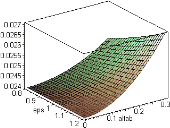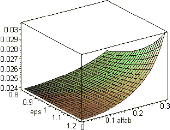
engineering & technology publications
ISSN 1759-3433
PROCEEDINGS OF THE SEVENTH INTERNATIONAL CONFERENCE ON COMPUTATIONAL STRUCTURES TECHNOLOGY
On the Generalised Perturbation-Based Stochastic Finite Element Method
Chair of Mechanics of Materials, Technical University of Lódz, Poland
The basic idea of the stochastic perturbation approach consists in Taylor series
expansion of all the parameters about their spatial expectations using some small
parameter
![]() ; it yields in case of random function
; it yields in case of random function ![]()
 |
(39) |
where
 |
(40) |
where
Therefore, the classical FEM approach for elastostatic problems is based on a solution for the following linear algebraic equations system:
| (41) |
 |
(42) |
The zeroth order solution is determined from the first equation of this system. Inserted into the next equation, it returns first order solution etc. until nth order equation solution is completed. After all the solution vector components are determined, their expected values, variances and the other probabilistic moments can be computed. Numerical convergence of the GSFEM is discussed using simple MAPLE symbolic computations of up to tenth order perturbation-based approximations for the expected values and standard deviations in tension of the linear elastic bar discretised with 10 one-dimensional linear finite elements.
The results of the analysis show that convergence of perturbation technique depends on coefficient of variation of random input (alfab) and, in smaller range, on the perturbation parameter (eps). Even the expected values for a simply tensioned homogeneous bar computed in 2nd (Figure 1) and 10th (Figure 2) order approaches differ by about 10% at the tensioned edge. Further comparative numerical studies with the other stochastic methods are necessary - improved Monte-Carlo analyses of analogous engineering problems would be recommended to establish the most efficient perturbation orders for different input and perturbation parameters and the non-Gaussian variables [3].
- 1
- M. Kaminski, "Stochastic perturbation approach in vibration analysis using Finite Difference Method", Journal of Sound and Vibration, 251(4): 651-670, 2001. doi:10.1006/jsvi.2001.3850
- 2
- M. Kleiber, T.D. Hien, The Stochastic Finite Element Method. Wiley, 1992.
- 3
- E. Vanmarcke, Random Fields. Analysis and Synthesis. MIT Press, 1983.
purchase the full-text of this paper (price £20)
go to the previous paper
go to the next paper
return to the table of contents
return to the book description
purchase this book (price £135 +P&P)

